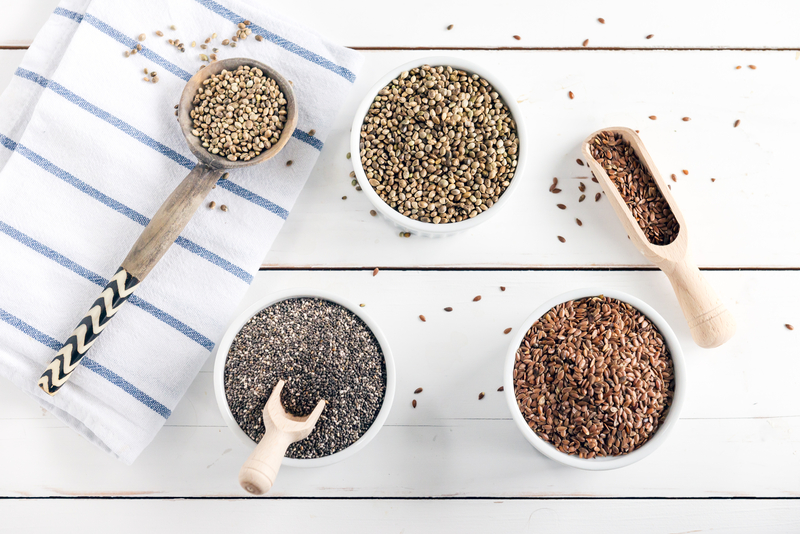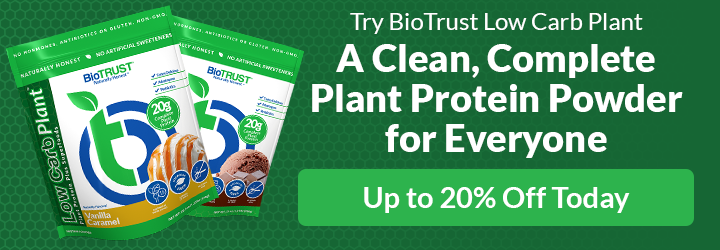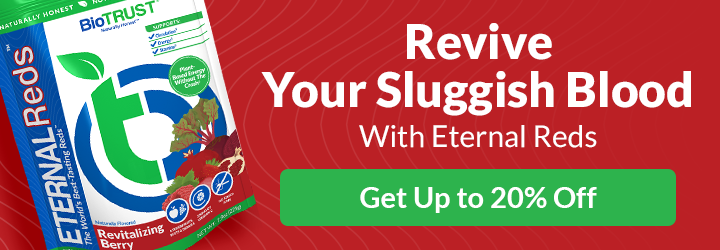The 6 Healthiest Seeds to Eat For Your Diet

Whether they’re sprinkled whole, crushed into smaller bits, dried, or pureed into spreads, tiny seeds offer huge health benefits when included in the diet. These superfoods offer quality plant-based protein, a wide range of nutrients (including vitamins, minerals, antioxidants, etc.), and healthy fats to provide long-lasting energy that outsizes their small proportions. Plus, they add amazing flavor and texture to meals.
All of them offer benefits, but which ones are healthiest seeds to eat? We’re glad you asked. Here are our top six picks and how to add them to your daily diet:
6 Healthiest Seeds to Eat
1. Chia Seeds
One ounce (around 2 tablespoons) provides 138 calories that are loaded with fiber (~10 grams per ounce), the omega-3 fatty acid alpha-linolenic acid (5 grams), and 23% of the daily value (DV) for magnesium, 16% for B3, 15% DV for B1, and 14% of the DV for calcium, and 12% DV for zinc as well as being an awesome source of antioxidants. In other words, chia seeds pack a huge nutritional punch. 1
They’ve been shown to help promote regularity, lower cholesterol and help support heart health, increase fullness to reduce food intake and support weight loss, and provide minerals to support bone mineral density. 2 – 6 They also appear to benefit blood sugar regulation and may improve insulin sensitivity. 7
Chia seeds can be added to smoothies, protein shakes, oatmeal, yogurt, baked goods, etc. One of the most popular ways to enjoy them is as a chia seed pudding like this delicious recipe to kickstart your morning. Just remember to drink lots of water when consuming chia as the seeds absorb liquid and may increase the risk of constipation if you’re dehydrated.
2. Flaxseeds
Another popular, healthy seed that provides a wide range of nutrients is flaxseed. A one-tablespoon serving provides only 37 calories with 2 grams of fiber (both soluble and insoluble), 3 grams of omega-3 fats, and just over a gram of protein. It also is high in thiamine (10% DV), copper (9% DV), manganese (8% DV), and many other nutrients.
Because it’s so high in omega-3 fatty acids (i.e., ALA), it may help lower cholesterol, reduce blood pressure, support heart health, control inflammation, stabilize blood sugar levels, prevent insulin resistance, and more. 9 – 11 Flaxseeds are also high in lignans, which have been shown to decrease the risk of various types of cancer. 12 – 14 The fiber found in flaxseed helps support gut health and improve regularity. 15
Flaxseeds have also been found in some 45 different studies to help manage weight, showing a decrease in not only weight but BMI and belly fat. This is due in part to the fiber content as it fills you up and slows digestion to reduce overall appetite, so you eat less. 16 – 18
Flaxseeds are also highly versatile. They can be added to smoothies, pancake or waffle batter, oatmeal (including overnight oats), baked goods, yogurt, burgers, and so much more as they provide a mild yet nutty flavor and enjoyable crunch. They can even be used as an egg substitute.
3. Pumpkin Seeds
Looking for a convenient, nutrient-packed snack? Pumpkin seeds can check every box as one of the healthiest seeds to eat. A one-ounce serving provides ~151 calories, almost 2 grams of fiber in 5 grams of carbs, and a surprising 7 grams of protein in such a small serving. Pumpkin seeds are also rich in several vitamins and minerals, including manganese (42% DV), magnesium (37% DV), phosphorus (33% DV), iron (23% DV), copper (19% DV), and vitamin K (18% DV). Pumpkin seeds are also a rich source of antioxidants like carotenoids and vitamin E.
Because pumpkin seeds are so high in nutrients, diets high in them have been linked to supporting a healthy inflammatory response, decreased risk of heart disease, and decreased risk of certain cancers, including breast cancer. 19 -22 For men, eating pumpkin seeds has been found to help support prostate and bladder health for greater quality of life. 23 – 24 Pumpkin oil has also been found to be helpful for women and men for better urinary function. 25
Pumpkin seeds provide a respectable amount of fiber and a high amount of magnesium, which may explain why they help regulate blood sugar levels, which may decrease the risk of developing type 2 diabetes. 26 – 28
The easiest way to add pumpkin seeds to the diet is to just enjoy them as a straight-up snack, either raw or roasted, salted or unsalted. But they also can be added to smoothies, to top a smoothie bowl or Greek yogurt, or on top of salads, soups, or even oatmeal. They can also be added to both savory and sweet breads and cakes.
4. Hemp Seeds
Another of the healthiest seeds to eat, hemp seeds are exceptionally high in protein (nearly 10 grams in 3 tablespoons, including all essential amino acids), comparable to beef or lamb by weight. They’re also high in fiber (just over one gram) and healthy fats (linoleic acid, alpha-linolenic acid, and gamma-linolenic acid). They’re rich in antioxidants, vitamins, and minerals, including vitamin E, magnesium, phosphorous, potassium, and B vitamins. 29
While hemp seeds come from the Cannabis sativa plant, they contain neglectable amounts of THC and no mind-altering effects. 30 That isn’t to say they don’t have an impact on the brain. In fact, research has shown brain protection or neuroprotective benefits due to its potential to aid in a healthy inflammatory and immune response. 31, 32
Hemp seeds are also a rich source of omega-3 fatty acids as well as the amino acid arginine, which may help lower blood pressure and protect against heart disease. Omega-3 fats may also improve skin health, including aiding those with dry skin, acne, and other skin conditions. 33, 34
Hemp seeds are another surprisingly versatile food with a nutty flavor that blends well with salads, oatmeal, yogurt, and smoothie bowls as well as sautéed with vegetables like kale or broccoli or sprinkled over roasted cauliflower.
5. Watermelon Seeds
Surprised? Most of us are more accustomed to spitting out watermelon seeds or choosing seedless varieties of the fruit. After all, many children grew up believing swallowing the seeds would lead to the growth of a watermelon in the belly. Yet watermelon seeds are surprisingly good for you. They’re low in calories (just 23 per large handful—about 4 grams) and provide a variety of nutrients, including magnesium (21 mg or 5% DV), zinc (26% DV), healthy fats, and antioxidants. 35
While fewer studies can be found on the specific benefits of watermelon seeds, because of their nutritional breakdown, they may help support heart health, regulate blood sugar levels and the metabolism of carbohydrates, promote skin and hair health, support strong bones, and more.
To eat, roast your watermelon seeds for around 10 minutes at 350 degrees F and then sprinkle them over salads or smoothie bowls. If you want to eat them raw, they can be easier to consume when sprouted unless you pick up a softer, lighter-colored variety that was grown for seed rather than fruit. Or, you can grind the seeds into a flour (powder) to add to a number of dishes. You can even find commercial brands of watermelon seed flour, which is grain- and gluten-free and provides more protein, iron, and zinc than almond flour.
How do they taste? Watermelon seeds have an almost sunflower-like flavor, though they’re more mild. For a simple, flavorful trail-mix alternative, combine 1/4 cup roasted watermelon seeds with 1/4 cup roasted pumpkin seeds. Season with your favorite flavors (e.g., cinnamon) and add 1 to 2 tablespoons of dried fruit and finish off with a couple of ounces of your preferred nut(s).
6. Pomegranate Seeds
Pomegranate seeds, also known as arils, are rich in nutrients as well as flavor and vibrant color. A half-cup serving of arils contains 72 calories, 3.5 grams of fiber, and around 1.5 grams of protein, along with a good amount of vitamin C, vitamin E, folate, potassium, and magnesium. Like the rest of the healthiest seeds to eat options, they’re also high in free-radical-fighting antioxidants and polyphenolic compounds, which can help boost overall health and potentially prevent disease. 36
In addition, the nutrients (including flavonoids, tannins, and lignans) found in pomegranates can help promote a healthy response to inflammation in the body, which may help reduce the risk of many diseases, including heart disease, diabetes, cancer, and Alzheimer’s. 37 – 39
Again, due to their high fiber content, including cellulose and lignin, as well as providing unique fatty acids like punicic acid, pomegranate seeds may help improve insulin sensitivity and promote weight loss. 40 – 42 In addition, pomegranate may help improve exercise endurance as well as muscle recovery. 43, 44
Other potential benefits of eating pomegranate seeds include supporting urinary health and preventing kidney stone formation, fighting harmful microorganisms (such as bacteria, fungi, and yeast), helping protect the brain and delay cognitive diseases, and support digestive health. 45 – 50
If you’ve never prepared a pomegranate before, it can be a bit intimidating. Fortunately, Coach Cristina shares the best way to get at the seeds in her Dark Chocolate Pomegranate holiday treat recipe. In addition to delicious desserts, pomegranate seeds can be eaten straight-up as a snack, sprinkled over salad greens, stirred into Greek yogurt or as a layer in yogurt parfaits, added to smoothies, added to fancy-looking drinks, and so much more!
Healthiest Seeds to Eat: A Recap
Any and all of the seeds above can be included in a healthy diet for numerous benefits. But they aren’t the only ones to consider. Others include:
- Sunflower Seeds: A rich source of folate and vitamin E, which can be enjoyed shelled and eaten as a snack or sprinkled over a salad or pasta or smoothie bowl. It also makes for an awesome alternative to nut butters.
- Sesame Seeds: This great source of iron and necessary addition (as tahini) for the perfect hummus, whole sesame seeds can also be added to numerous recipes like stir-fries and roasted broccoli or Brussels sprouts.
- Spice Seeds from caraway to cumin, fennel, anise, poppy, coriander, mustard, fenugreek, etc. not only add a powerful punch of flavor but can also improve the nutritional impact of your meal. For example, they provide minerals, healthy fats, and even a little extra protein.
The bottom line is that seeds provide healthy fats, quality plant-based protein, fiber, and antioxidants, which can be a boon to overall health and potentially even decrease the risk of disease. Plus, they’re an extremely easy and convenient ingredient to increase the nutritional content of just about any recipe—whether it’s a breakfast smoothie, yogurt- and fruit-based dessert, summer salad, or roasted vegetable for dinner. Like nuts, however, it is important to watch serving sizes as calories can add up fairly quickly.






 US Doctor: "Eating This Every Day Can Snap You Into Ketosis"
US Doctor: "Eating This Every Day Can Snap You Into Ketosis" 3 Key Nutrients to Help Lubricate Your "Tin Man" Joints
3 Key Nutrients to Help Lubricate Your "Tin Man" Joints AVOID Plant-Based Protein Powders (unless...)
AVOID Plant-Based Protein Powders (unless...)

